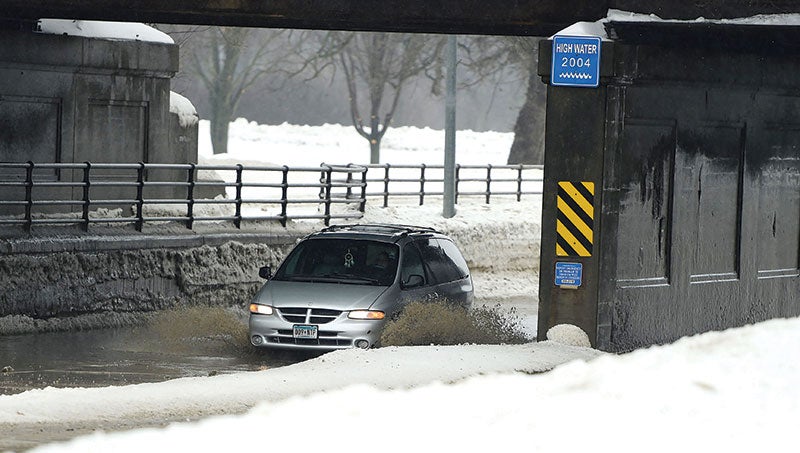Where are you, Spring? Flooding an increased concern for Austin area
Published 7:08 am Tuesday, March 12, 2019

- A minivan rolls through pooling water underneath the overpass over Oakland Avenue East Saturday. While the area missed this past weekend’s storm, the amount of snow along with any precipitation the area might receive could cause significant flooding this spring. Eric Johnson/photodesk@austindailyherald.com
As southeast Minnesota continues to thaw from the brunt of winter storms, there’s another concern that may be flooding into the area.
Temperatures are beginning to rise as spring makes its way into the region, with highs going into the 40s and lows in the 30s by mid-week, according to the National Weather Service in La Crosse (NWS). That being said, extensive snow melts and ice jams are the focus of concern for potential flooding.
With several rounds of rain in the forecast, there’s also potential for thunderstorms by Wednesday night, with rainfalls amounting to an inch or more possible by Friday morning.
“That said, there’s some question as to how much rain is going to fall,” said Clint Aegerter, NWS meteorologist. “We’re more concerned with snowmelt and runoff from that as we will be warming up quite a bit. Our main concern is definitely ice jams with the warmups.”
It’s difficult to say how much flooding the Austin area could experience this upcoming spring, but the amount would be significant due to the above-average snowfall that the region received this winter. According to NWS, the Cedar River had a 50/50 chance of being over or just under the moderate flood stage for this spring, possibly rising to 17.3 feet, which is under the 18-feet moderate flood stage, but above the 15-feet minor flood stage.
The NWS is working with river forecasters in the Twin Cities to determine the exact levels of precipitation the area could see as well as potential flooding issues. Those who live close to riverways and other areas prone to flooding are advised to keep an eye on the rising water levels and take action if flooding does occur. For now, it’s best to approach the upcoming weeks with caution as the NWS weighs out the possibility of issuing a flood watch at some point in the next few weeks.
“The whole question is what are temperatures going to do?” Aegerter said. “Be on the lookout for some high water, expect some rain and snowmelt.”
Austin Public Works Director Steven Lang said that while flooding could happen, it is not too likely.
“When it comes to snow melts, we haven’t had a snowmelt flood since the 1960s,” he said. “It’s something we’ll watch and keep in mind, but past history tells us it hasn’t been an issue.”
Any sign of spring?
Although the temperatures are rising, Minnesotans probably shouldn’t break out the shorts just yet. The long-term outlook for the next few weeks shows that temperatures will dip back down into the cooler temperatures. However, this cool down may assist with minimizing flooding.
“We don’t want it to be freezing all the time, but it’s better than getting warm at the end of the month and all the flooding releasing all at once,” Aegerter said. “A happy medium would be nice. The best case scenario is for the snow to melt a little during the day, and then freezing overnight. That would definitely help mitigate some things. We definitely want to get the awareness out. It’s well above the normal flooding risk for our entire area. Not saying that we’re definitely getting some flooding, but the conditions are all favorable for that.”
Lang said that heavy water can build up at intersections because of freezing sewers.

Steven Lang, Austin Public Works Director
“Storm sewers will freeze up and plug with ice, so the city will have to use jetters or steamers to melt the ice and get water flowing,” he said. “Once we get a storm sewer open, the water usually cuts through (the ice) as it continues to drain and will open up those pipes.”
Lang said that street crews will keep an eye on problematic areas as well as main and secondary roadways that carry heavy traffic.
Rising temperatures and rain will also have an impact on the amount of water in the street.
“We anticipate a lot of the compaction on the residential roadways will start to melt,” Lang said, pointing out that the city will employ snow plows and other equipment to help clear the slush. Lang said the snow plows will only clear streets they can get through.
“People are going to have to abide by the even/odd parking rule under our emergency snow ordinance in order for us to clear the streets,” he said.
Hannah Yang and Michael Stoll contributed to this article



